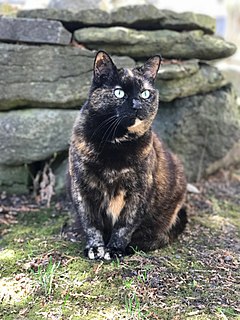 W
WA bicolor cat or piebald cat is a cat with white fur combined with fur of some other color, for example black or tabby. There are various patterns of bicolor cat. These range from Turkish Van pattern through to solid color with a throat locket.
 W
WA black cat is a domestic cat with black fur that may be a mixed or specific breed, or a common domestic cat of no particular breed. The Cat Fanciers' Association (CFA) recognizes 22 cat breeds that can come with solid black coats. The Bombay breed is exclusively black. All-black fur pigmentation is slightly more prevalent in male cats than female cats. Their high melanin pigment content causes most black cats to have yellow (golden) eyes (irises).
 W
WA calico cat is a domestic cat of any breed with a tri-color coat. The calico cat is most commonly thought of as being typically 25% to 75% white with large orange and black patches ; however, the calico cat can have any three colors in its pattern. They are almost exclusively female except under rare genetic conditions. A calico is not to be confused with a tortoiseshell, which has a mostly mottled coat of black/orange or grey/cream with relatively few to no white markings. However, outside North America, the calico pattern is more usually called tortoiseshell and white. In the province of Quebec, Canada, they are sometimes called chatte d'Espagne. Other names include brindle, tricolor cat, mike neko (三毛猫), and lapjeskat ; calicoes with diluted coloration have been called calimanco or clouded tiger. Occasionally, the tri-color calico coloration is combined with a tabby patterning; this calico-patched tabby is called a caliby.
 W
WA Maltese is any cat whose fur is either completely, or primarily, gray or blue and is of indeterminate breed.
 W
WAn Oriental bicolour is any cat of Oriental type, either long-haired or short-haired and in any pattern including colourpoint, which has white areas on its coat caused by the white spotting gene. In most cat fancier and breeder organisations, Oriental bicolours do not constitute a standardised breed, but a coat pattern variant of the breed of their foundation stock. One breed registry is an exception, the UK-based Governing Council of the Cat Fancy (GCCF), which has defined them as a separate breed named Oriental Bicolour (capitalised).
 W
WA piebald or pied animal is one that has a pattern of unpigmented spots (white) on a pigmented background of hair, feathers or scales. Thus a piebald black and white dog is a black dog with white spots. The animal's skin under the white background is not pigmented.
 W
WA tabby is any domestic cat with a distinctive 'M' shaped marking on its forehead, stripes by its eyes and across its cheeks, along its back, and around its legs and tail, and, characteristic striped, dotted, lined, flecked, banded or swirled patterns on the body—neck, shoulders, sides, flanks, chest and abdomen. "Tabby" is not a breed of cat but a coat type seen in almost all genetic lines of domestic cats, regardless of status. The tabby pattern is found in many official cat breeds and is a hallmark of the landrace extremely common among the general population of cats around the world. The tabby pattern occurs naturally and is connected both to the coat of the domestic cat's direct ancestor and to those of their close relatives: the African wildcat, the European wildcat and the Asiatic wildcat, all of which have similar coats, both by pattern and coloration. A genetic study of tabbies found five genetic clusters to be ancestral to cats of various parts of the world.
 W
WTortoiseshell is a cat coat coloring named for its similarity to tortoiseshell material. Like calicos, tortoiseshell cats are almost exclusively female. Male tortoiseshells are rare and are usually sterile.